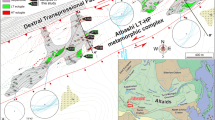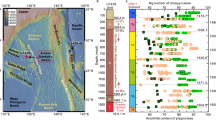Abstract
Mount Etna lies near the boundary between two regions that exhibit significantly different types of volcanism. To the north, volcanism in the Aeolian island arc is thought to be related to subduction of the Ionian lithosphere1. On Sicily itself, however, no chemical2,3 or seismological4 evidence of subduction-related volcanism exists, and so it is thought that the volcanism—including that on Mount Etna itself—stems from the upwelling of mantle material5, associated with various surface tectonic processes1,6. But the paucity of geological evidence regarding the primary composition of magma from Mount Etna means that its source characteristics remain controversial. Here we characterize the trace-element composition of a series of lavas emitted by Mount Etna over the past 500 kyr and preserved as melt inclusions inside olivine phenocrysts. We show that the compositional change in primary magmas from Mount Etna reflects a progressive transition from a predominantly mantle-plume source to one with a greater contribution from island-arc (subduction-related) basalts. We suggest that this is associated with southward migration of the Ionian slab, which is becoming juxtaposed with a mantle plume beneath Sicily. This implies that the volcanism of Mount Etna has become more calc-alkaline, and hence more explosive, during its evolution.
This is a preview of subscription content, access via your institution
Access options
Subscribe to this journal
Receive 51 print issues and online access
$199.00 per year
only $3.90 per issue
Buy this article
- Purchase on Springer Link
- Instant access to full article PDF
Prices may be subject to local taxes which are calculated during checkout



Similar content being viewed by others
References
Barberi, F., Gasparini, P., Innocenti, F. & Villari, L. Volcanism of the southern Tyrrhenian Sea and its geodynamic implications. J. Geophys. Res. 78, 5221–5232 (1974).
Bianchini, G., Clocchiatti, R., Coltorti, M., Joron, J. L. & Vaccaro, C. Petrogenesis of mafic lavas from the northernmost sector of the Iblean district (Sicily). Eur. J. Mineral. 10, 301–315 (1998).
Tanguy, J. C. Tholeiitic basalt magmatism of Mount Etna and its relations with the alkaline series. Contrib. Mineral. Petrol. 66, 51–67 (1978).
Anderson, H. & Jackson, J. The deep seismicity of the Tyrrhenian Sea. Geophys. J. R. Astron. Soc. 91, 613–637 (1987).
Tanguy, J. C., Condomines, M. & Kieffer, G. Evolution of the Mount Etna magma: Constraints on the present feeding system and eruptive mechanism. J. Volcanol. Geotherm. Res. 75, 221–250 (1997).
Gvirtzman, Z. & Nur, A. The formation of Mount Etna as the consequence of slab rollback. Nature 401, 782–785 (1999).
Keller, J. Petrology of some volcanic rock series of the Aeolian Arc, Southern Tyrrhenian Sea: Calc-alkaline and shoshonitic associations. Contrib. Mineral. Petrol. 45, 29–47 (1974).
Gillot, P. Y., Kieffer, G. & Romano, R. The evolution of Mount Etna in the light of potassium-argon dating. Acta Vulcanol. 5, 81–87 (1994).
Busà, T., Clocchiatti, R. & Cristofolini, R. Low P and high P alkaline magmas from Mt Etna: their origin and evolution from the study of mineralogy and chemistry of lavas and of olivine-trapped inclusions. Periodico Mineralogia 68, 163–183 (1999).
Condomines, M., Tanguy, J. C. & Michaud, V. Magma dynamics at Mt Etna: Constraints from U-Th-Ra-Pb radioactive disequilibria and Sr isotopes in historical lavas. Earth Planet. Sci. Lett. 132, 25–41 (1995).
La Delfa, S., Patanè, G., Clocchiatti, R., Joron, J. L. & Tanguy, J. C. Activity of Mount Etna preceding the February 1999 fissure eruption: inferred mechanism from seismological and geochemical data. J. Volcanol. Geotherm. Res. 105, 121–139 (2001).
Trua, T. Evoluzione del magmatismo ibleo (Sicilia sud orientale) dal Cretaceo al Plio-Pleistocene. Thesis, Univ. Pisa (1997).
Gioncada, A. et al. A study of melt inclusions at Vulcano (Aeolian Islands, Italy): insights on the primitive magmas and on the volcanic feeding system. Bull. Volcanol. 60, 286–306 (1998).
Weaver, B. L. The origin of ocean-island basalt end-member compositions: trace element and isotopic constraints. Earth Planet. Sci. Lett. 104, 381–397 (1991).
Hofmann, A. W. Mantle geochemistry: the message from oceanic volcanism. Nature 385, 219–229 (1997).
Albarede, F. et al. OIB-type magmas in subduction zones: mantle counterflow above detaching plates. Eos 81, 1271 (2000).
Ferrari, L. & Manetti, P. Geodynamic framework of the Tyrrhenian volcanism: a review. Acta Vulcanol. 3, 1–19 (1993).
Feigenson, M. D., Hofmann, A. W. & Spera, F. J. Case studies on the origin of basalt. II. The transition from tholeiitic to alkalic volcanism on Kohala volcano, Hawaii. Contrib. Mineral. Petrol. 84, 390–405 (1983).
Wendt, J. L., Regelous, M., Collerson, K. D. & Ewart, A. Evidence for a contribution from two mantle plumes to island-arc lavas from northern Tonga. Geology 25, 611–614 (1997).
Turner, S. & Hawkesworth, C. Using geochemistry to map mantle flow beneath the Lau Basin. Geology 26, 1019–1022 (1998).
Morris, J. D. & Hart, S. R. Isotopic and incompatible element constraints on the genesis of island arc volcanics from Cold Bay and Amak Island, Aleutians, and implications for mantle structure. Geochim. Cosmochim. Acta 47, 2015–2030 (1983).
Tanguy, J. C., Kieffer, G. & Patanè, G. Dynamics, lava volume and effusion rate during the 1991–1993 eruption of Mount Etna. J. Volcanol. Geotherm. Res. 71, 259–265 (1996).
Joron, J. L. & Treuil, M. Etude géochimique et pétrogénèse de laves de l'Etna, Sicile, Italie. Bull. Volcanol. 47, 1125–1144 (1984).
Metrich, N. & Clocchiatti, R. Sulfur abundance and its speciation in oxidized alkaline melts. Geochim. Cosmochim. Acta 60, 4151–4160 (1996).
Lanzafame, G. & Bousquet, J. C. The Maltese escarpment and its extension from Mt. Etna to the Aeolian Islands (Sicily): importance and evolution of a lithosphere discontinuity. Acta Vulcanol. 9, 113–120 (1997).
Coltelli, M., Del Carlo, P. & Vezzoli, L. Discovery of a Plinian basaltic eruption of Roman age at Etna Volcano, Italy. Geology 26, 1095–1098 (1998).
Bottazzi, P., Ottolini, L., Vannucci, R. & Zanetti, A. in Secondary Ion Mass Spectrometry SIMS IX (eds Beninghoven, A., Nikei, Y., Shimizu, R. & Werner, H. W.) 927–930 (Wiley & Sons, Chichester, 1994).
Schiano, P., Allègre, C. J., Dupré, B., Lewin, E. & Joron, J. L. Variability of trace elements in basaltic suites. Earth Planet. Sci. Lett. 119, 37–51 (1993).
Hofmann, A. W. Chemical differentiation of the Earth: the relationship between mantle, continental crust, and oceanic crust. Earth Planet. Sci. Lett. 90, 297–314 (1988).
Allègre, C. J., Schiano, P. & Lewin, E. Differences between oceanic basalts by multitrace element ratio topology. Earth Planet. Sci. Lett. 129, 1–12 (1995).
Acknowledgements
We thank J. C. Tanguy, A. Borgia, O. Sigmarsson, R. Cristofolini and B. Van Wyk de Vries for discussions, A. Kent for comments on the manuscript, and the Consiglio Nazionale delle Ricerche (Italy) for funding the ion microprobe that we used at CSCC (Pavia).
Author information
Authors and Affiliations
Corresponding author
Supplementary information
Rights and permissions
About this article
Cite this article
Schiano, P., Clocchiatti, R., Ottolini, L. et al. Transition of Mount Etna lavas from a mantle-plume to an island-arc magmatic source. Nature 412, 900–904 (2001). https://doi.org/10.1038/35091056
Received:
Accepted:
Issue Date:
DOI: https://doi.org/10.1038/35091056
This article is cited by
-
Phases in fine volcanic ash
Scientific Reports (2023)
-
Isotopic evolution of prehistoric magma sources of Mt. Etna, Sicily: Insights from the Valle Del Bove
Contributions to Mineralogy and Petrology (2021)
-
Slab narrowing in the Central Mediterranean: the Calabro-Ionian subduction zone as imaged by high resolution seismic tomography
Scientific Reports (2018)
-
Ultrafast syn-eruptive degassing and ascent trigger high-energy basic eruptions
Scientific Reports (2018)
-
Mt. Etna plumbing system revealed by combined textural, compositional, and thermobarometric studies in clinopyroxenes
Contributions to Mineralogy and Petrology (2016)
Comments
By submitting a comment you agree to abide by our Terms and Community Guidelines. If you find something abusive or that does not comply with our terms or guidelines please flag it as inappropriate.



